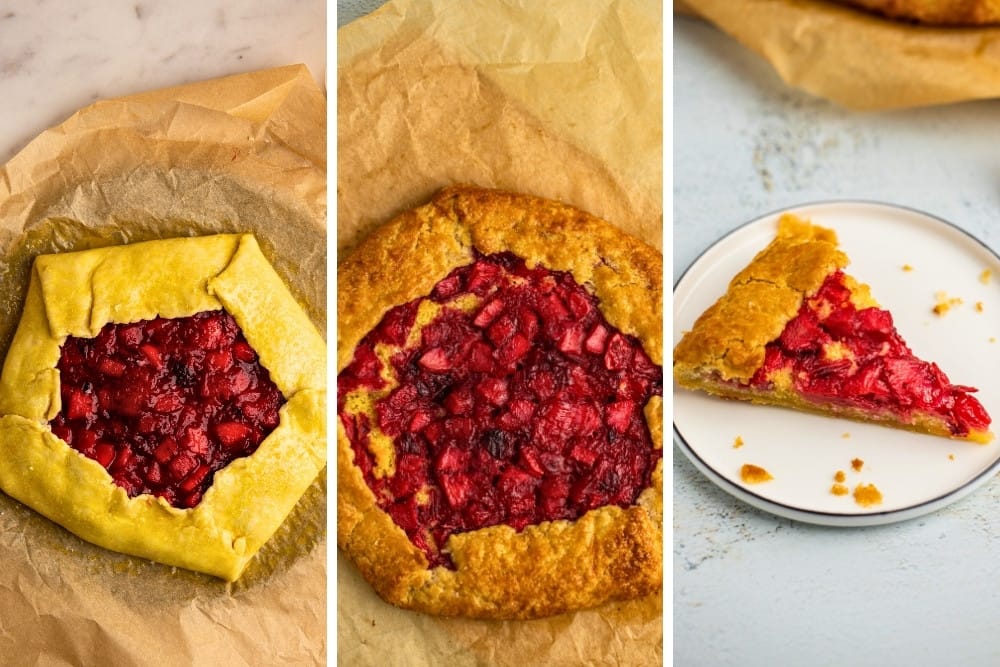How to Make Fruit Galettes (and Every Variation You’ll Ever Want)
Everything you need to make foolproof, flaky, beautifully rustic tarts with any fruit, any season.
This post may contain affiliate links. Read our privacy policy.
Sweet galettes look beautifully rustic and effortless, but behind that simplicity is a smart formula: flaky dough, juicy filling, and just enough structure to keep everything crisp and caramelized.
This guide will walk you through every part of that formula so you can make galettes that come out reliably great — the kind with tender fruit (not watery filling), crisp bottoms, and golden edges that shatter when you cut into them.
You’ll learn the three essential components (dough, base layer, fruit), how to make a flaky dough (two methods), how to prep fruit fillings, and exactly how to assemble and bake a galette so it holds its shape and turns out beautifully every time. Plus, you’ll find plenty of extra tips to take you from first-time galette baker to confident home baker who can create endless variations with zero stress.
Here for the method? Start from the top.
Want recipe ideas? Jump straight to the flavor section.
Editor’s Note: I spent 7+ hours putting this guide together (not counting testing the recipes or shooting the photos). My goal is to make this your one-stop galette reference — base formulas, fruit prep methods, troubleshooting tips, and lots of flavor ideas. Bookmark it, use it, and if there’s something you’d love to see added, tell me — I’ll keep updating this guide as the galette library grows.
What’s a Galette?
A galette is a rustic, free-form tart made by rolling out pastry dough, piling fruit (and sometimes a thin layer of cream) in the center, and folding the edges in just enough to hold everything together. Unlike pies, there’s no pan, no crimping, and no pressure for it to look perfectly even.
That’s what makes galettes so beginner-friendly. The dough doesn’t need to fit a dish, you don’t have to worry about shrinking crusts, and you can adjust the shape as you go. Even if the folds are uneven or a little juice escapes, it still bakes into something beautiful (and delicious!).
A great galette has:
- Flaky, buttery pastry
- Juicy fruit with a balanced sweet-tart flavor
- Caramelized, golden edges
When those three elements come together, you get the perfect slice: crisp and golden on the outside, tender and fruity on the inside. Impressive, delicious, and far more relaxed than pie.
Now that we know what a galette is, let’s talk about how to build one.
Basic Galette Formula
A galette has three core components. Once you understand these, you can mix and match fruit, flavors, and doughs with confidence.
The Dough
The dough is your foundation. For most galettes, a simple all-butter pastry dough works beautifully — it’s flaky, flavorful, and sturdy enough to hold the fruit. You can also experiment with variations, and in a pinch, store-bought puff pastry works too.
The Base Layer (Optional, But Powerful)
The base layer sits between the dough and the fruit. Its job is twofold:
- Add flavor (think almond, hazelnut, etc.)
- Absorb extra fruit juice so the crust stays crisp.
A classic choice is frangipane, a simple almond-based cream that goes well with many fruits.
The Fruit Layer
This is the star. How good your fruit layer is how good your galette is.
But fruit = water — and too much water = soggy galette.
So we’ll manage that with:
- Thickeners (like cornstarch)
- Maceration (mixing fruit with sugar and salt, then letting it sit) + draining
- Cooking the fruit first (fruit compotes work wonderfully in galettes)
The goal is juicy, not soupy.
With the components out of the way, the assembly is straightforward:
Roll the dough → Add the base → Arrange the fruit → Fold the edges → Chill → Bake.
We’ll walk through each piece in detail next.
Galette Dough 101
There are a lot of great dough recipes out there, so if you already have a favorite flaky pie dough, feel free to use it. If not, here’s a reliable all-butter dough that works beautifully for just about any galette.
All-Butter Flaky Pie Dough
Ingredients (for one medium galette):
- 1 ¼ cups (150 g) all-purpose flour
- 1 Tbsp (14 g) sugar
- ½ tsp salt
- 8 Tbsp (113 g / 1 stick) cold unsalted butter, cut into cubes
- 3 Tbsp ice-cold water
- ½ tsp lemon juice or vinegar (optional — helps keep the crust tender)
(These proportions are adapted from Brian Lagerstrom’s Apple Galette dough, scaled down slightly.)
Method 1: Food Processor
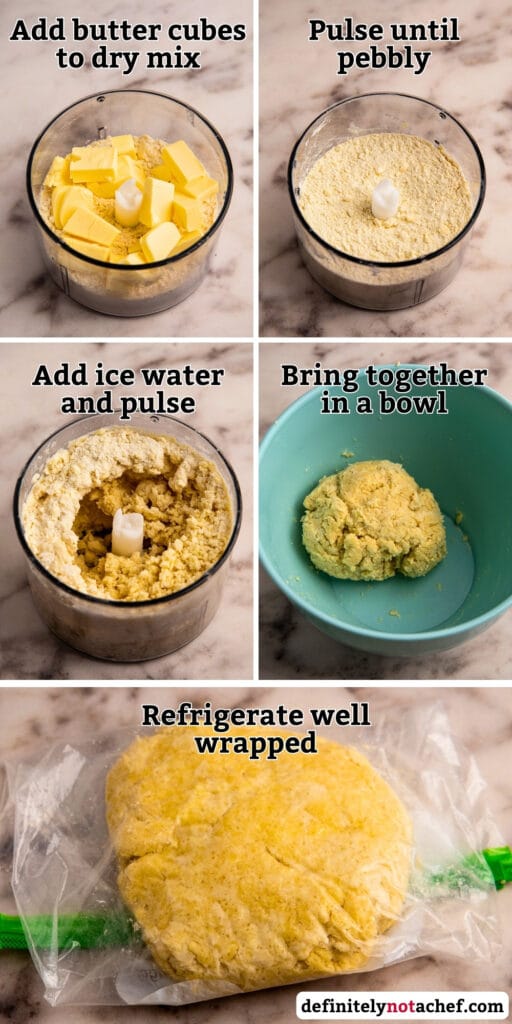
- Combine dry ingredients. Add flour, sugar, and salt to the food processor. Pulse to combine.
- Cut in the butter. Add the cold butter cubes and pulse a few times until the mixture looks pebble-like with visible butter pieces.
- Add water. Add ice water and lemon juice and pulse 6–10 times, just until the dough starts to come together in clumps. It should not form one smooth ball yet.
- Bring it together. Transfer the dough to a bowl and gently press it together with your hands into a rough ball. No kneading. This should take less than a minute.
- Wrap. Wrap in plastic wrap (or put into a reusable plastic bag and squeeze out the air) and flatten into a disk.
- Refrigerate. Refrigerate for at least 1 hour before rolling.
Method 2: Pastry Cutter / Knife
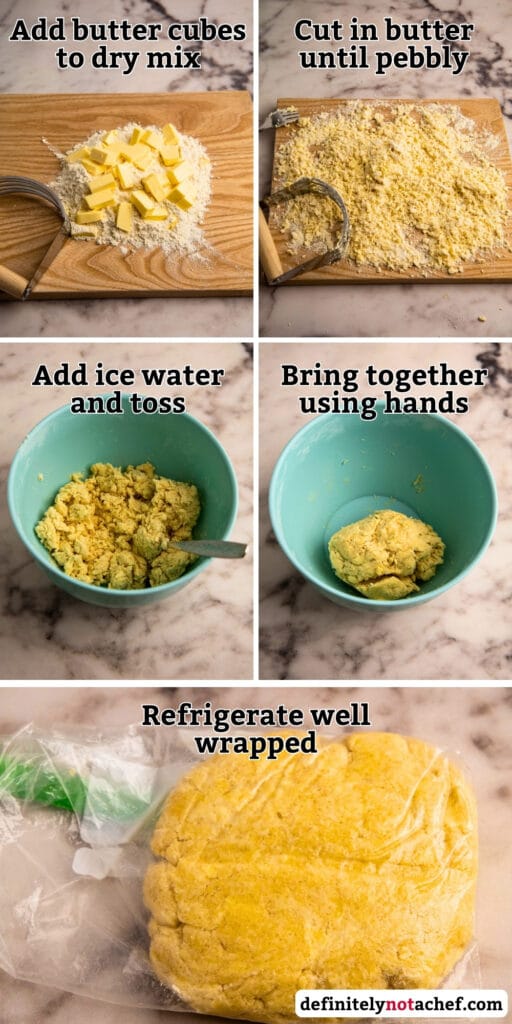
- Combine dry ingredients. Whisk the flour, sugar, and salt in a bowl.
- Cut in the butter. Add the butter cubes and use a pastry cutter (or two knives) to cut into the flour until you have mostly pea-sized pieces. A few larger flakes are good — they make it flaky. If you’re using a plastic bowl, cut the butter into the flour on a large cutting board, then transfer back into the bowl (your pastry cutter will destroy your plastic bowl, I tested).
- Add water gradually. Drizzle in the lemon juice and about half the water and toss with a fork. Add the rest a little at a time, stopping when the dough holds together when lightly pressed. It should still look a bit shaggy.
- Bring it together gently. Press into a rough ball using your hands. No kneading. This should take less than a minute.
- Wrap. Wrap in plastic wrap (or put into a reusable plastic bag and squeeze out the air) and flatten into a disk.
- Refrigerate. Refrigerate for at least 1 hour before rolling.
Dough Success Tips
- Keep everything cold. Cold butter = visible butter pockets = flaky layers. If the butter starts to soften, pause and chill it in the fridge for 30 minutes or in the freezer for 10 minutes.
- Minimal handling with your hands. Press to combine, don’t knead or work it smooth. We don’t want a gluten structure to develop and make the dough tough. Or to warm up and soften the butter.
- Rest time matters. Chilling hydrates the flour and firms the butter. Overnight is even better if you have the time.
Now that we got the dough, it’s time to make the filling.
Making Galette Filling
A galette typically has one or two layers of filling: a base layer and the main flavor layer (usually fruit).
The Base Layer
The base layer is typically quick to prepare and adds both flavor and protection — it keeps the crust crisp by creating a barrier between the fruit and the dough.
A classic choice is frangipane: a simple almond cream made from butter, sugar, egg, and ground almonds (or almond flour).
The Main Layer
The main layer brings the flavor. How much work it takes depends on your approach.
Let’s go over popular options.
Option 1: Fresh Fruit
This is the simplest route and works especially well for firm, low-water fruits like apples, pears, or stone fruits.
Here are the steps:
- (Optional) Macerate. Toss sliced fruit with sugar (and a pinch of salt) and let it sit for about 30 minutes. The sugar draws out excess water and softens the fruit. Afterward, you can discard the liquid or simmer it to reduce and concentrate the flavor before adding it back in. This liquid has lots of flavor, but will make the galette soggy, hence the reduction.
- Mix with flavorings. Combine the fruit with sugar, lemon juice, cornstarch (for thickening), and spices if desired (like cinnamon for apples or cardamom for plums).
- Use immediately. Spread the fruit evenly over the base layer or directly on the dough.
Pros: Quick and easy — perfect when you want minimal prep.
Cons: You can’t fully control the flavor or moisture content. If the fruit is less sweet or releases more juice than expected, the flavor balance may be off, or the galette might take much longer to bake.
Option 2: Pre-Cooked Fruit
Pre-cooking takes a bit more time but gives you far more control. You’re essentially making a fruit compote — cooking the fruit until tender, flavorful, and perfectly thickened.

Here’s the high-level overview:
- Mix. Combine cut fruit with a splash of water, sugar, and a pinch of salt in a pot. Bring to a gentle boil.
- Soften and evaporate. Simmer until the fruit is soft and most liquid has cooked off. Or thicken with a small amount of cornstarch.
- Season to taste. Remove from heat, then adjust with more sugar or lemon juice until the flavor is just right.
- Cool completely. Spread the fruit in a thin layer on a plate to cool faster.
- Use once cooled. Spread the cooled fruit evenly over your base layer or dough.
Pros: You can taste and adjust the flavor before baking, so the result is exactly what you want. Plus, pre-cooked fruit won’t leak excess juice, meaning a crisper crust and a neater galette.
Cons: Takes an extra 15–20 minutes to cook and cool before use.
Bottom Line
If you’re new to galettes, pre-cooked fruit is the safest path to great results. It takes a little more time but guarantees balanced flavor and a crisp, flaky crust.
Now that the filling’s ready, let’s put everything together.
Assembling and Baking a Galette
Here’s how to assemble your galette, step by step.
- Ensure the Dough Is Cold. Your dough should be nicely chilled before rolling. Some bakers let it sit out for 10–15 minutes to soften slightly, but that’s not necessary (at least in my experience).
- Roll the Dough. Lightly flour your work surface, then place the dough on top and dust it with a bit more flour. Roll it into a rough 10-inch (25 cm) circle, about 3 mm thick (use rolling pin guides if you have them). Turn the dough every few rolls to prevent sticking: lift it gently onto your arm, dust the work surface, then lay it back down (on the other side) and continue rolling. If the edges crack (they often do with cold dough), just press and smooth them with your hands. Don’t worry about making a perfect circle — a slightly uneven shape looks beautifully rustic once baked.
- Transfer the Dough. Gently roll the dough onto the rolling pin to transfer. Unroll onto a round, flat base lined with parchment paper — something that fits easily into your fridge (like the base of a springform pan). This makes it easy to chill and transfer later. Aim for a base larger than 7 inches (18 cm) wide, slightly larger than the galette itself.
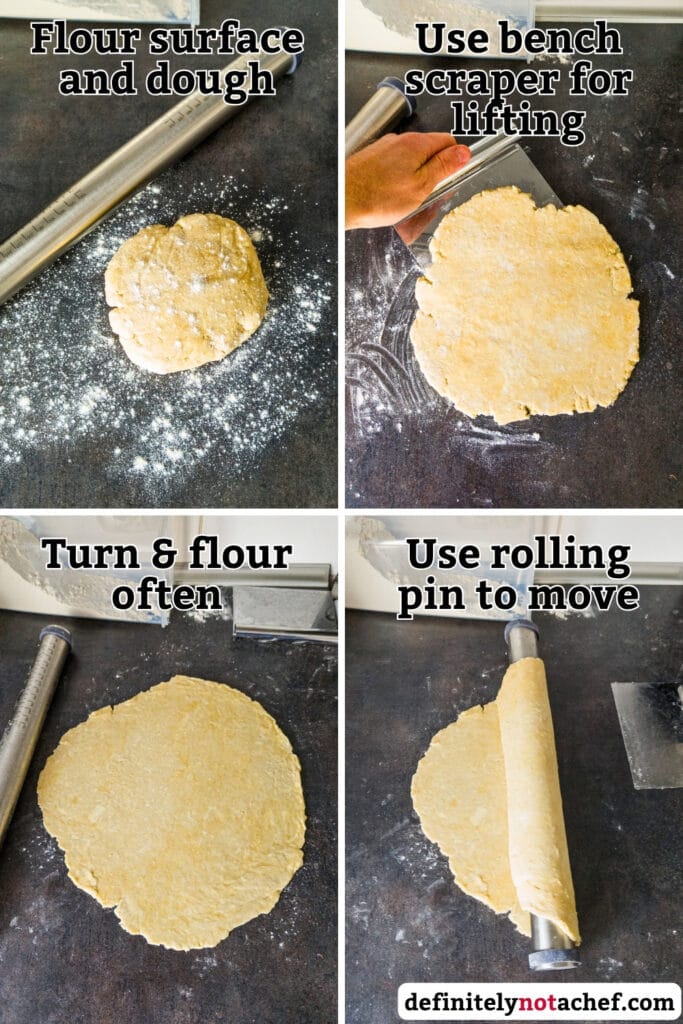
- Add the Base Layer. If you’re using one (like frangipane), spread it evenly over the dough, leaving a 1½-inch (4 cm) border for folding.
- Add the Fruit Layer. Spoon your prepared fruit filling into the center and spread it evenly, again leaving that 1½-inch (4 cm) border. If you’re using fresh fruit slices, you can arrange them neatly or go for a more rustic look — both work.
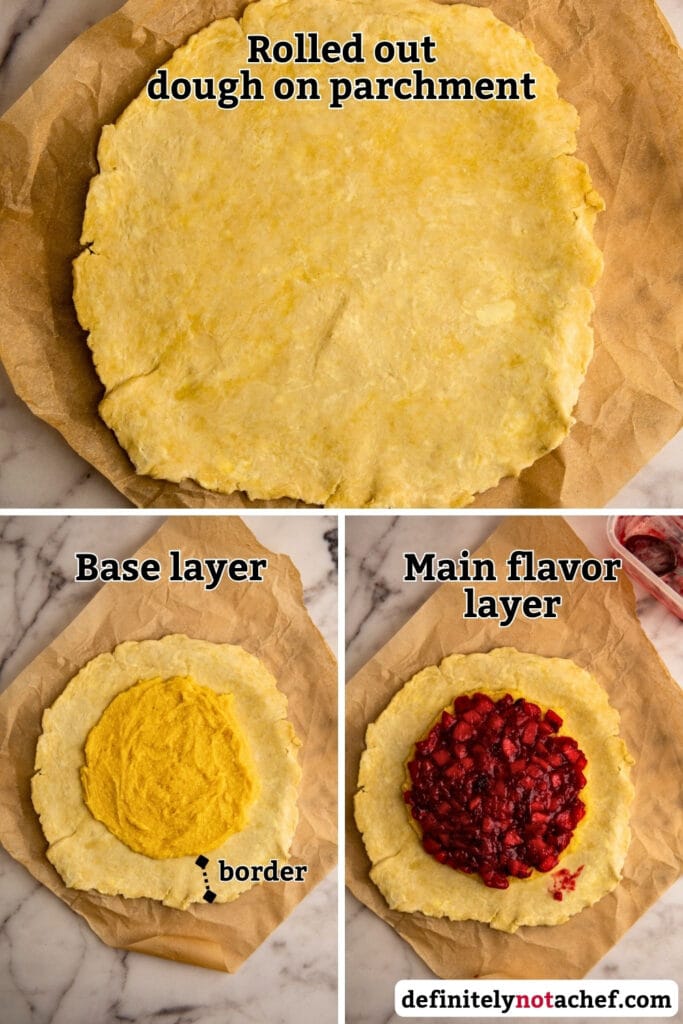
- Fold the Pleats. Lift the edges of the dough and fold them over the fruit, overlapping as you go. Start where the border is narrowest and continue clockwise (or counterclockwise) until fully enclosed. I usually end up with about 5 folds. Gently press each fold to help it stick.
- Refrigerate. Chill the assembled galette for at least 15 minutes before baking. This helps it hold its shape and keeps the butter cold for extra flakiness.
- Preheat the Oven. Preheat your oven to 375°F (190°C) while the galette chills.
- Egg Wash and Sugar. Once preheated, take the galette out of the fridge. Brush the exposed crust with egg wash (about one-third of a beaten egg mixed with a tiny splash of water), then sprinkle with sugar of your choice — white, brown, or raw sugar depending on the fruit. Optionally, finish with a pinch of flaky salt for a sweet-salty contrast.

- Bake. Slide the galette (with parchment) onto a baking sheet. Bake for 40–50 minutes (or 30-40 minutes if there’s no base layer), until the crust is deeply golden and the fruit is bubbling and tender.
- Cool Before Serving. Fresh fruit galettes often come out quite juicy. Let it cool so the filling can set — at least 30 minutes if possible. Even when set, a warm galette can be fragile, so serve on plates with forks or spoons rather than slicing and eating by hand.

Rolling Success Tips
- Turn the dough often. It prevents sticking and keeps the shape even.
- Flour lightly, but often. Add small amounts as needed.
- Use a bench scraper (or the back of a chef’s knife) to lift and turn the dough — much easier than using your hands.
- If it starts to tear, transfer it onto parchment paper (lightly dusted with flour) and finish rolling there. Add flour as needed but skip turning.
Baking Success Tips
- Check after 75% of baking time. If the crust is golden but the fruit still looks watery, reduce oven temp to 320°F (160°C) to let the filling cook through without over-browning the crust.
- Watch the bubbles. Large, slow bubbles = juices thickened; fast bubbling = still watery, needs more time. If it’s past baking time and filling still looks watery, reduce to 320°F (160°C) and continue baking for another 10 to 15 minutes. If the filling has been thickened before baking (say, you made a blueberry compote and thickened is with cornstarch), there won’t be any bubbles. Instead, expect the filling slowly pulsing up and down in waves.
- For creamy bases that need cooking (like frangipane): insert a thermometer or a skewer. The center should reach 185°F (85°C), and a skewer should come out mostly clean (no wet creamy filling that smells eggy).
Galette Flavors
Now that the techniques are out of the way, let’s look at how to turn all of this into actual galettes — from simple classics to more unique combinations.
Easy Fruit Galette Setup
Here’s an easy approach if you just want a dependable, no-stress fruit galette:
- Make any of the compotes from my fruit compote guide (aim for about 1 pound of fruit, 20-30% more for watery ones).
- Spread it over your galette dough and bake for 30–40 minutes until the crust is crisp and the compote bubbles slowly.
It’s simple, forgiving, and always delicious.
Ready to explore flavor ideas? Jump to the ones you’re interested in:
Apple Cranberry Frangipane

Apple cranberry frangipane galette brings creamy almond frangipane together with apples and cranberries for a balance of nutty sweetness and lively tartness.
It’s an excellent fall and winter galette, perfect for Thanksgiving and the holiday season when you want something seasonal but not overly fussy.
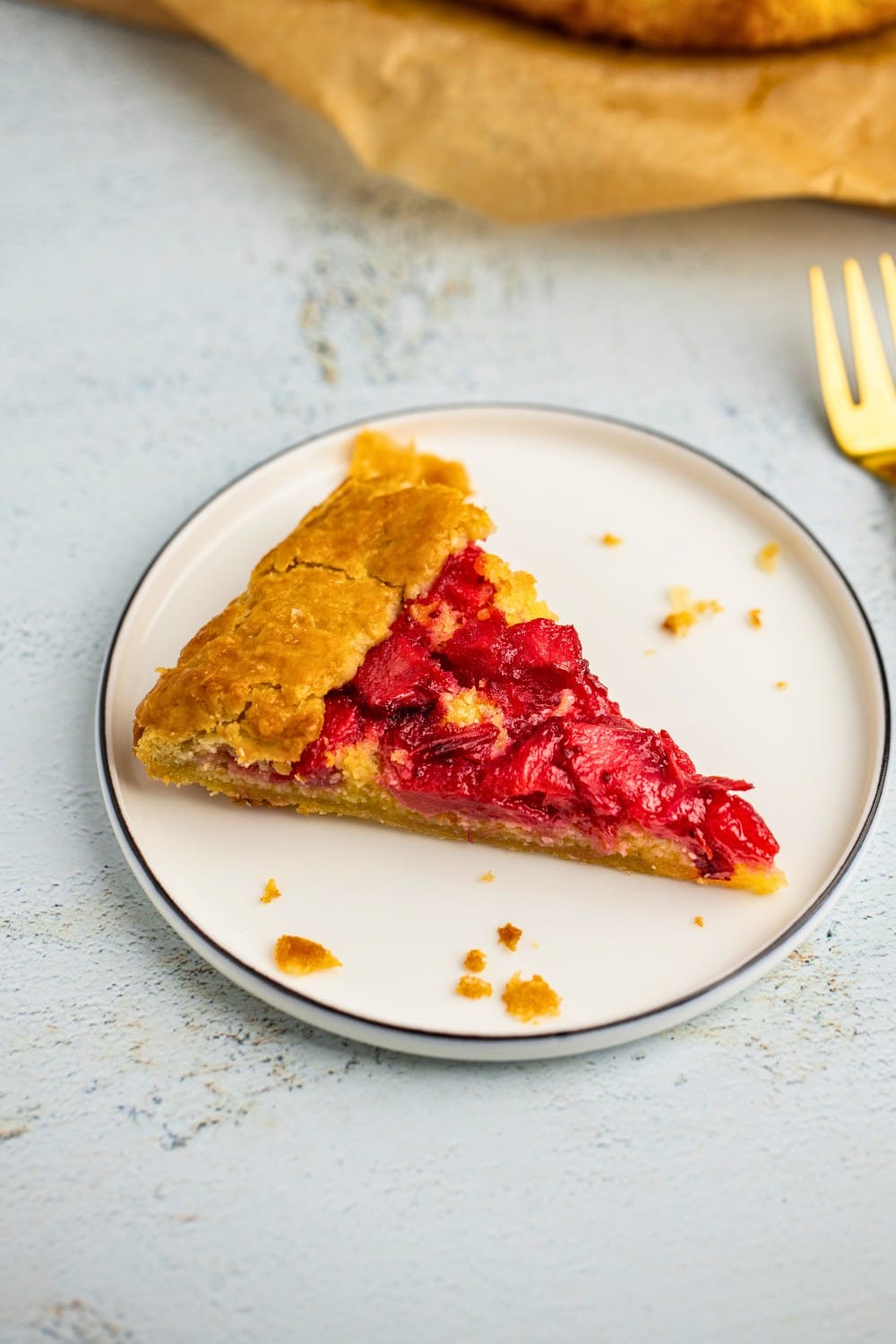
Equipment
- Food processor
Ingredients
Galette Dough
- 1 ¼ cups all-purpose flour 150 g
- 1 tablespoon sugar 13 g
- ½ teaspoon salt
- 8 tablespoons unsalted butter cold; 113 g (1 stick); cut into cubes
- 3 ⅓ tablespoons ice-cold water 50 g
- ½ teaspoon lemon juice or vinegar
Frangipane Cream
- 1 large egg ~50 g after cracking
- ¼ cup sugar ~50 g
- 3½ tablespoons unsalted butter room temperature; ~50 g
- ½ cup almond flour or ground almonds; ~50 g
Apple Cranberry Compote
- 3 apples medium; cubed — about 3 cups (300 g) after cubing
- 1 cup cranberries 100 g; fresh or frozen
- 2 tablespoons white sugar 26 g; more to taste
- ⅛ teaspoon salt
- 2 tablespoons orange juice 30 g
- orange zest from ½ orange; optional but recommended
Instructions
Make Dough
- Combine Dry Ingredients: Add the flour, sugar, and salt to the food processor and pulse to combine.1 ¼ cups all-purpose flour, 1 tablespoon sugar, ½ teaspoon salt
- Cut In The Butter: Add the cold butter cubes and pulse a few times until the mixture looks pebble-like with visible butter pieces.8 tablespoons unsalted butter
- Add Ice Water And Lemon: Add the ice water and lemon juice and pulse 6–10 times, just until the dough starts to come together in clumps; it should not form one smooth ball yet.3 ⅓ tablespoons ice-cold water, ½ teaspoon lemon juice
- Bring It Together: Transfer the dough to a bowl and gently press it together with your hands into a rough ball—no kneading—and this should take less than a minute.
- Wrap The Dough: Wrap the dough in plastic wrap (or put it into a reusable plastic bag and squeeze out the air) and flatten it into a disk.
- Chill The Dough: Refrigerate the wrapped dough for at least 1 hour before rolling.
Cook Apple Cranberry Compote
- Prep Fruit: Wash, peel, and chop the apples; wash and sort the cranberries, discarding any soft ones.3 apples, 1 cup cranberries
- Cook The Compote: In a pot combine the orange juice, apples, cranberries, sugar, salt, and orange zest; stir and bring to a boil over medium heat, stirring occasionally until the apples release some water.2 tablespoons orange juice, 2 tablespoons white sugar, ⅛ teaspoon salt, orange zest
- Simmer Until Soft: Once boiling, reduce to low and cook until the apples are tender, most cranberries have burst, and much of the liquid has evaporated, stirring every minute or two to prevent scorching; remove from the heat while it’s a bit thinner than you’d like as it will thicken as it cools.
- Adjust Sweetness: Taste and stir in more sugar or a splash of orange juice if needed until the flavor is balanced.
- Cool To Room Temperature: Let the compote cool to room temperature before adding it to the galette.
Prepare Frangipane Cream
- Cream Butter And Sugar: Whisk the room-temperature butter and sugar together until smooth and combined.3½ tablespoons unsalted butter, ¼ cup sugar
- Add Almond Flour: Stir in the almond flour and whisk until fully combined into the cream.½ cup almond flour
- Add The Egg: Stir in the egg until the frangipane is soft and spreadable.1 large egg
- Store Or Use: Use the frangipane immediately or cover and refrigerate for later use.
Assembly And Baking
- Ensure Dough Is Cold: Make sure the dough is well chilled before rolling so it handles easily and stays flaky.
- Roll The Dough: Lightly flour your work surface and roll the dough into a rough 10-inch (25 cm) circle about 3 mm thick, turning and dusting as needed and pressing any cracked edges with your hands; a slightly uneven shape is fine.
- Transfer To Base: Place the rolled dough onto a round, flat base lined with parchment—something that fits in your fridge and is slightly larger than the galette.
- Spread Frangipane: Spread the frangipane cream evenly over the dough, leaving a 1–5 inch (4 cm) border for folding.
- Add Compote: Spoon the cooled apple-cranberry compote into the center and spread it evenly, leaving that same 1–5 inch (4 cm) border.
- Fold The Edges: Lift and fold the dough edges over the fruit, overlapping to form pleats (usually about five), gently pressing each fold to help it stick.
- Chill Assembled Galette: Refrigerate the assembled galette for at least 15 minutes to help it hold its shape and keep the butter cold for extra flakiness.
- Preheat The Oven: Preheat your oven to 375°F (190°C) while the galette chills.
- Brush Egg Wash: Remove the galette from the fridge, brush the exposed crust with egg wash (about one-third of a beaten egg mixed with a splash of water), then sprinkle with brown or white sugar and a pinch of flaky salt if you like.
- Bake The Galette: Slide the galette on its parchment onto a baking sheet and bake 40–50 minutes, until the crust is deeply golden and the fruit is bubbling and tender.
- Cool And Serve: Let the galette cool for at least 30 minutes if possible before slicing and serving.
Notes
- Refer to the step-by-step writeup above for detailed instructions and photos. For more info see apple cranberry compote and frangipane cream .
Nutrition
Apple Mixed Berries Frangipane
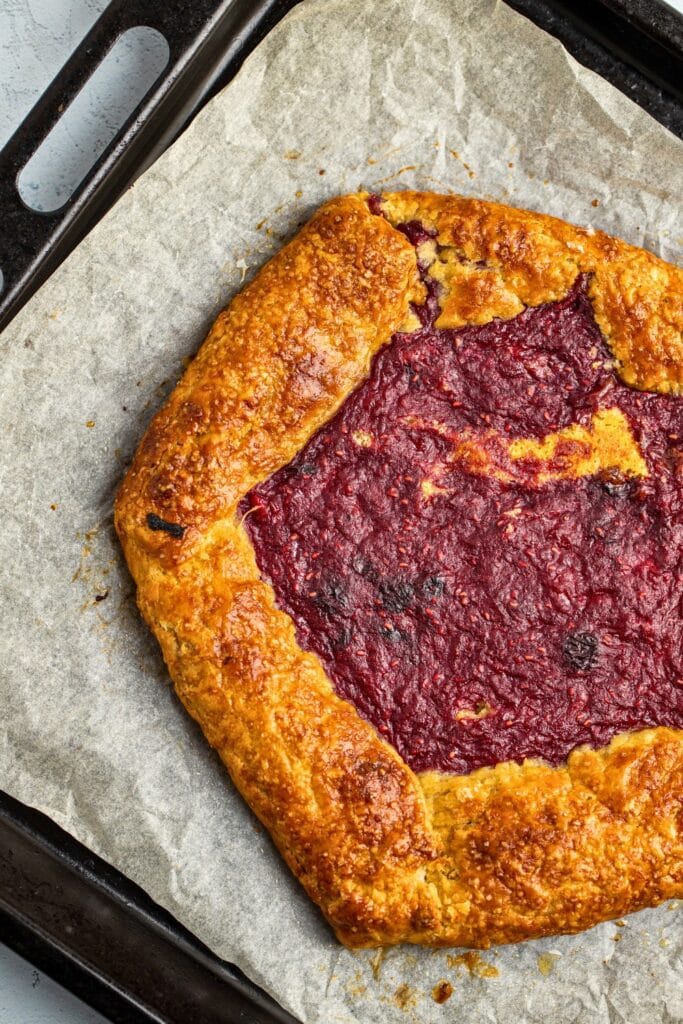
Bright berry acidity and apple sweetness meet a creamy almond filling for a galette that tastes lively yet gently rich. Perfect for late-summer brunches when berries are at their peak or slightly warm on a cold winter afternoon.
Super easy prep, and the apple berry compote is pre-cooked and thickened before baking, so you don’t have to worry about it coming out wet and soupy.

Ingredients
Dough
- 1 ¼ cups all-purpose flour 150 g
- 1 tablespoon sugar 13 g
- ½ teaspoon salt
- 8 tablespoons unsalted butter cold, 113 g or 1 stick, cut into cubes
- 3 ⅓ tablespoons water ice-cold, 50 g
- ½ teaspoon lemon juice or vinegar
Frangipane Cream
- 1 piece egg large, ~50 g after cracking
- ¼ cup sugar ~50 g
- 3 ½ tablespoons unsalted butter room temperature, ~50 g
- ½ cup almond flour or ground almonds, ~50 g
Apple Mixed Berries Compote
- 1 ½ piece apple medium, ~225 g
- 1 ½ cups mixed berries ~225 g
- 1 ½ tablespoons white sugar 20 g, more to taste
- 1 teaspoon lemon juice more to taste
- pinch salt
- 1 ½ tablespoons cornstarch ~12 g
- 1 ½ tablespoons water 23 g
Instructions
Make Dough
- Combine Dry Ingredients: Add the all-purpose flour, sugar, and salt to the food processor and pulse a few times just to combine so the dry mix is uniform.1 ¼ cups all-purpose flour, 1 tablespoon sugar, ½ teaspoon salt
- Cut In Butter: Add the cold butter cubes to the processor and pulse a few more times until the mixture looks pebble-like with visible bits of butter about the size of peas.8 tablespoons unsalted butter
- Add Ice Water: Add the ice-cold water and the lemon juice, then pulse about 6–10 times just until the dough begins to form clumps — it should not make one smooth ball yet.3 ⅓ tablespoons water, ½ teaspoon lemon juice
- Bring Dough Together: Transfer the mixture to a bowl and gently press it with your hands into a rough ball; do not knead — this should take less than a minute.
- Wrap And Flatten: Wrap the dough tightly in plastic wrap (or put it in a reusable bag and squeeze out the air) and flatten it into a disk for easier chilling and rolling later.
- Chill Dough: Refrigerate the wrapped disk for at least 1 hour before rolling so the butter firms and the dough rests.
Cook Apple Mixed Berries Compote
- Prep Fruit: Peel, core, and cube the apples. Wash and hull the berries if using fresh, and cut large strawberries into smaller pieces; if using frozen berries, no need to defrost first.1 ½ piece apple, 1 ½ cups mixed berries
- Cook Fruit: Put the cubed apples, berries, sugar, and a pinch of salt in a pot with a splash of water so the fruit doesn’t stick. Cook over medium heat, bring to a boil while stirring occasionally, then reduce to low and simmer until frozen berries are thawed and apple cubes are softened.1 ½ tablespoons white sugar, pinch salt
- Adjust Flavor: Remove the pot from heat and add about half the lemon juice, then taste. If needed, add a bit more sugar for sweetness, more lemon juice for brightness, or a touch more salt to lift the flavors until the compote balances to your liking.1 teaspoon lemon juice
- Thicken Compote: In a small bowl stir the water and then the cornstarch until uniform. Pour about half the slurry into the pot while stirring, return to heat and cook until it thickens. If it's not spoonable yet, add another 1/2–3/4 of the remaining slurry and repeat. Once spoonable, cook about 1 minute more on low to remove any cornstarch aftertaste.1 ½ tablespoons water, 1 ½ tablespoons cornstarch
- Finish Compote: Take the compote off heat and taste one last time; adjust with a little more sugar or lemon if needed.
- Cool Compote: Spread the compote on shallow plates to cool faster, and refrigerate once cooled if you won’t assemble the galette right away.
Prepare Frangipane Cream
- Cream Butter And Sugar: Whisk the room-temperature butter and sugar together until smooth and combined.3 ½ tablespoons unsalted butter, ¼ cup sugar
- Add Almond Flour: Stir in the almond flour and whisk until the mixture is well combined and smooth.½ cup almond flour
- Stir In Egg: Add the egg and stir until the frangipane is soft, spreadable, and homogeneous.1 piece egg
- Store or Use: Use the frangipane immediately or cover and refrigerate it for later use.
Assembly And Baking
- Ensure Dough Cold: Make sure the dough is well chilled before you roll it so the butter stays cold and the crust is flaky.
- Roll The Dough: Lightly flour your work surface and dust the dough with a bit of flour, then roll into a rough 10-inch (25 cm) circle about 3 mm thick, turning the dough every few rolls and dusting the surface as needed; press and smooth any cracked edges by hand.
- Transfer Dough: Gently roll the dough onto your rolling pin and unroll it onto a round, parchment-lined flat base (slightly larger than the galette and at least 7 inches/18 cm wide) so it’s easy to chill and transfer later.
- Spread Frangipane: Evenly spread the frangipane cream over the dough, leaving a 1 1/2 inch (4 cm) border for folding.
- Add Fruit Compote: Spoon the cooled apple and mixed berries compote into the center and spread it evenly, keeping that 1 1/2 inch (4 cm) border clear.
- Fold Pleats: Lift the dough edges and fold them over the fruit, overlapping as you go to create 5–6 pleats; start where the border is thinnest and work clockwise (or counterclockwise), gently pressing each fold to help it stick.
- Chill Assembled Galette: Refrigerate the assembled galette for at least 15 minutes to help it hold its shape and keep the butter cold for extra flakiness.
- Preheat Oven: Preheat your oven to 375°F (190°C) while the galette chills so it’s ready to bake.
- Egg Wash And Sugar: Brush the exposed crust with an egg wash (about one-third of a beaten egg with a tiny splash of water), then sprinkle with white sugar and, optionally, a pinch of flaky salt for contrast.
- Bake Galette: Slide the galette (on the parchment) onto a baking sheet and bake 40–50 minutes until the crust is deeply golden and the frangipane is set (a toothpick should not come out wet and eggy).
- Cool And Serve: If possible, let the galette cool for at least 30 minutes before slicing so the filling sets and slices cleanly.
Notes
- If you don’t have almond flour or whole almonds, skip the frangipane and increase apples to 2 and mixed berries to 2 cups — the flavor will be less complex but still delicious.
- Make sure the apple–mixed-berries compote tastes right before thickening. The amount of sugar needed varies widely by fruit – flavor to taste.
- The compote recipe uses roughly a 1:1 ratio of berries to apples. Use more apples for a firmer texture and less tartness.
- After adding cornstarch, keep stirring the compote continuously while it’s on the heat to avoid burning.
- You can make your own berry mix — for example, equal parts strawberries, blueberries, and raspberries.
- Refer to the step‑by‑step writeup above for detailed instructions and photos. See these guides for more info: compote, frangipane.
Nutrition
Blueberry

This blueberry galette follows the “easy fruit galette setup” I outlined earlier: galette dough filled with fruit compote. And because frozen berries work perfectly, it’s one you can make any time of year.
The filling leans bright and jammy, with blueberries, a bit of lemon, and a faint savory lift from a pinch of salt. It’s an easy pick for a casual brunch or a relaxed weeknight dessert.

Ingredients
Dough
- 1 ¼ cups all-purpose flour 150 g
- 1 tablespoon sugar 13 g
- ½ teaspoon salt
- 8 tablespoons unsalted butter cold; 113 g (1 stick); cut into cubes
- 3 ⅓ tablespoons ice-cold water 50 g
- ½ teaspoon lemon juice or vinegar
Blueberry Compote
- 3 cups blueberries 450-480 g; fresh or frozen
- ¼ cup white sugar 50 g; more to taste
- lemon zest from 1/4 lemon; optional
- 2 teaspoons lemon juice more to taste
- pinch salt
- 2 tablespoons cornstarch ~20 g
- 2 tablespoons water 30 g
Instructions
Make Dough
- Combine Dry Ingredients: Add the flour, sugar, and salt to the food processor and pulse just to combine.1 ¼ cups all-purpose flour, 1 tablespoon sugar, ½ teaspoon salt
- Cut In Butter: Add the cold butter cubes and pulse a few times until the mixture looks pebble-like with visible butter pieces.8 tablespoons unsalted butter
- Add Water And Lemon: Add the ice-cold water and lemon juice and pulse 6–10 times, just until the dough starts to come together in clumps without forming one smooth ball.3 ⅓ tablespoons ice-cold water, ½ teaspoon lemon juice
- Bring Dough Together: Transfer the mixture to a bowl and gently press it with your hands into a rough ball—no kneading; this should take less than a minute.
- Wrap Dough: Wrap the dough in plastic (or a reusable bag with the air squeezed out) and flatten it into a disk.
- Chill Dough: Refrigerate the wrapped disk for at least 1 hour before rolling.
Cook Blueberry Compote
- Cook Blueberries: In a pot add a little water, the blueberries (no need to defrost if frozen), sugar, a pinch of salt, and lemon zest if using; stir and bring to medium heat, then to a boil, stirring occasionally until the berries release their juices.3 cups blueberries, ¼ cup white sugar, lemon zest, pinch salt
- Adjust Flavor: Remove from heat and taste. Add lemon juice (1/2 tsp at a time) if it needs acidity (it will if you haven't used lemon zest) or a bit more sugar if it needs sweetness. Adjust until the balance is right.2 teaspoons lemon juice
- Thicken Compote: In a small bowl stir the cornstarch and water to make a slurry, pour about half into the pot while stirring, then return to heat and stir until it thickens. Add more slurry in portions if until it's fairly thick and spoonable (something you'd gladly top a cheesecake or waffles with). Once thick enough, cook on low for about a minute to remove any cornstarch aftertaste.2 tablespoons water, 2 tablespoons cornstarch
- Finish The Compote: Off the heat, taste once more and adjust with a little more sugar or lemon juice if needed.
- Cool The Compote: Spread the compote on shallow plates to cool faster. Refrigerate if cold and not using immediately.
Assembly and Baking
- Ensure Dough Is Cold: Make sure the chilled dough is cold before you roll to help keep the crust flaky.
- Roll The Dough: Lightly flour your work surface and dust the dough, then roll into a rough 10-inch (25 cm) circle about 3 mm thick, turning and lifting the dough often to prevent sticking. Press and smooth any cracked edges using your fingers.
- Transfer The Dough: Roll the dough onto the rolling pin to move it, then unroll onto a round, parchment-lined base that fits in your fridge (aim for a base just larger than the galette).
- Add Blueberry Compote: Spoon the cooled compote into the center and spread it evenly, leaving a 1½-inch (4 cm) border around the edge.
- Fold The Pleats: Lift the dough edges and fold them over the filling, overlapping as you go (start where the border is thinnest), creating about 5–6 folds and gently pressing each to help them stick.
- Chill Assembled Galette: Refrigerate the assembled galette for at least 15 minutes to help it hold its shape and keep the butter cold.
- Preheat Oven: While the galette chills, preheat the oven to 375°F (190°C).
- Egg Wash And Sugar: Brush the exposed crust with about one-third of a beaten egg mixed with a splash of water, then sprinkle with white sugar and optionally finish with a pinch of flaky salt.
- Bake The Galette: Slide the galette (on the parchment) onto a baking sheet and bake 35–40 minutes until the crust is deeply golden. The filling is already cooked through and thickened, so no need to worry about it reducing more or thickening.
- Cool And Serve: If possible, let the galette cool for at least 30 minutes before slicing to set the filling.
Notes
- Filling is pre-cooked — you don’t need to bring it to a target temperature; focus on baking the crust until nicely done (golden).
- If this is your first time, follow the step-by-step writeup above for detailed instructions and photos, the check out blueberry compote article.
Nutrition
Cherry Frangipane Galette
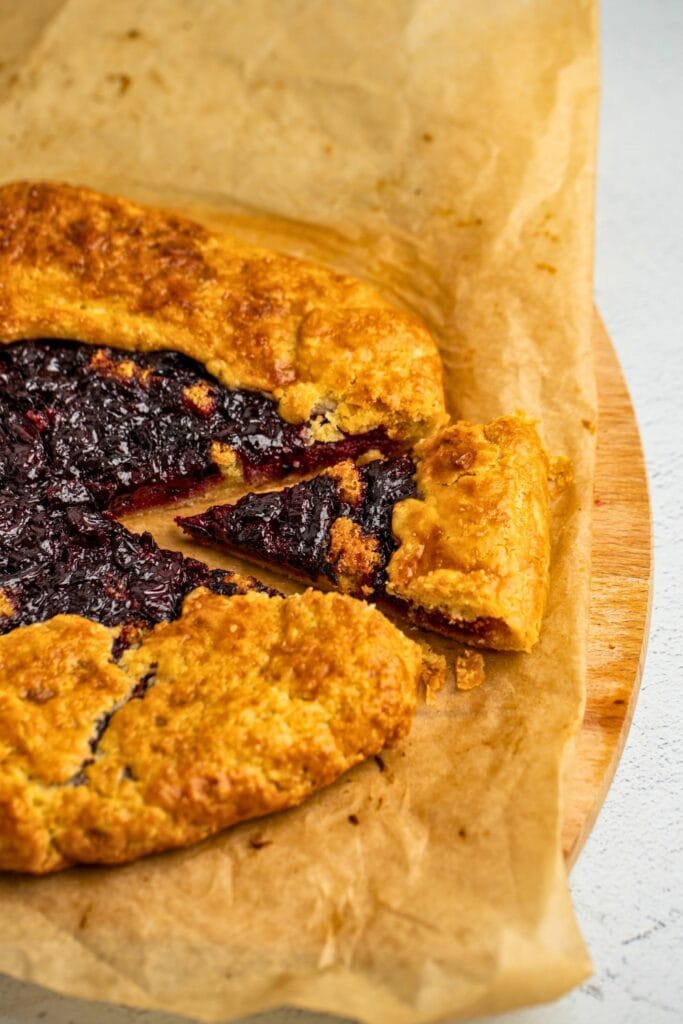
Cherry frangipane galette brings together bright, tart sour cherries and a buttery almond cream for a compact, rustic dessert. Delicious in the summer, but you can easily make it any time of year using frozen cherries (Thanksgiving, maybe?).

Ingredients
Dough
- 1 ¼ cups all-purpose flour 150 g
- 1 tablespoon sugar 13 g
- ½ teaspoon salt
- 8 tablespoons unsalted butter cold, 113 g (1 stick), cut into cubes
- 3 ⅓ tablespoons water ice-cold, 50 g
- ½ teaspoon lemon juice or vinegar
Frangipane Cream
- 1 piece egg large, ~50 g after cracking
- ¼ cup sugar ~50 g
- 3 ½ tablespoons unsalted butter room temperature, ~50 g
- ½ cup almond flour or ground almonds, ~50 g
Cherry Compote
- 1 pound sour cherries pitted, ~450 g, fresh, frozen, canned or jarred all work (drained)
- ¼ cup sugar ~50 g
- 1 tablespoon lemon juice 15 g
- pinch salt
Instructions
Make Dough
- Combine Dry Ingredients: Add the flour, sugar, and salt to the food processor and pulse just to combine.1 ¼ cups all-purpose flour, 1 tablespoon sugar, ½ teaspoon salt
- Cut In Butter: Add the cold butter cubes and pulse a few times until the mixture looks pebble-like with visible butter pieces.8 tablespoons unsalted butter
- Add Water: Add the ice water and lemon juice and pulse about 6–10 times, just until the dough starts to come together in clumps; it should not form one smooth ball yet.3 ⅓ tablespoons water, ½ teaspoon lemon juice
- Bring It Together: Transfer the mixture to a bowl and gently press it with your hands into a rough ball—no kneading; this should take less than a minute.
- Wrap The Dough: Wrap the dough in plastic (or put it in a reusable bag and squeeze out the air) and flatten into a disk.
- Refrigerate Dough: Chill the wrapped disk for at least 1 hour before rolling.
Cook Cherry Compote
- Cook Cherries: Put a bit of water in a pot to cover the bottom, add the cherries, salt, and sugar, stir, then bring to a boil over medium heat, stirring occasionally until the cherries start to sweat and release their juices.1 pound sour cherries, pinch salt, ¼ cup sugar
- Reduce: Once boiling, lower to low and cook until the cherries are soft and most of the liquid has evaporated, stirring more often near the end to avoid scorching; remove from heat when it's a bit thinner than you'd like as it will thicken while cooling.
- Finish Compote: Stir in the lemon juice, taste, and adjust with more sugar or lemon juice as needed.1 tablespoon lemon juice
- Cool Compote: Let the compote cool to room temperature before adding it to the galette.
Prepare Frangipane Cream
- Cream Butter And Sugar: Whisk the room-temperature butter and sugar together until smooth.3 ½ tablespoons unsalted butter, ¼ cup sugar
- Add Almond Flour: Stir in the almond flour and whisk until combined.½ cup almond flour
- Add Egg: Stir in the egg until the frangipane is soft and spreadable.1 piece egg
- Store Frangipane: Use the cream immediately or cover and refrigerate for later use.
Assembly and Baking
- Keep Dough Cold: Make sure the dough is cold before rolling to help achieve a flaky crust.
- Roll The Dough: Lightly flour your work surface and roll the dough into a rough 10-inch (25 cm) circle about 3 mm thick, turning and dusting as needed and repairing any edge cracks with your hands.
- Transfer To Base: Gently roll the dough onto a rolling pin and unroll it onto a parchment-lined round base that fits in your fridge to chill and make later transfer easy.
- Spread Frangipane: Spread the frangipane evenly over the dough, leaving a 1.5-inch (4 cm) border for folding.
- Add Cherry Compote: Spoon the cooled compote into the center and spread it evenly, again leaving the 1.5-inch (4 cm) border.
- Fold The Edges: Lift and fold the dough edges over the filling, overlapping to form pleats (about five folds), pressing each gently to help it stick.
- Chill Assembled Galette: Refrigerate the assembled galette for at least 15 minutes to firm up before baking.
- Preheat Oven: Preheat the oven to 375°F (190°C) while the galette chills.
- Egg Wash And Sugar: Brush the exposed crust with egg wash (about one-third of a beaten egg mixed with a splash of water), sprinkle with white sugar, and optionally add a pinch of flaky salt.
- Bake Galette: Slide the galette on its parchment onto a baking sheet and bake for 40–50 minutes until the crust is deeply golden and the fruit is bubbling and tender.
- Cool And Serve: Let the galette cool for at least 30 minutes if possible before slicing and serving.
Notes
- Cherries release a ton of water; use a wide, shallow pan instead of a pot to speed evaporation and shorten cooking time.
- If this is your first time, follow the step-by-step writeup above for detailed instructions and photos. For more detail see cherry compote and frangipane cream recipe writeups.
Nutrition
FAQ
How do I Store Galettes?
Sweet galettes taste best the day they’re baked, but you can store them in the fridge for 3–4 days. I usually slice mine and keep the pieces in airtight containers.
Freezing baked galettes isn’t recommended — the fruit tends to release water as it thaws, making everything soggy.
Can You Freeze Galette Dough?
Yes. Galette dough freezes very well. Wrap it tightly and freeze for up to 3 months for best quality. It’s a great way to prep ahead so you always have dough ready to go.
Before freezing, make the dough and chill it in the fridge for at least one hour so the flour hydrates. Then choose one of the following:
- Freeze the dough as a disc (easiest). Keep the dough wrapped, place it in a freezer bag for extra protection, and freeze. To use: thaw the dough overnight in the fridge, then roll out as usual.
- Freeze the dough rolled out (most convenient to use). This takes more prep, but it’s perfect if you like being able to bake on a whim. Roll out the dough, transfer it onto a flat base lined with parchment, then cover the top with another sheet of parchment (it’s easier to peel off than plastic wrap). Wrap the whole thing tightly in plastic wrap and freeze. To use: remove the plastic wrap, one by one peel off both parchments and place them back loosely (so it’s easier to remove the top and peel the dough later), and transfer the dough to the fridge. After about 2 hours, it should be ready to fill. In a pinch, 20 minutes at room temperature also works.
How to Prep Your Galette Over 1–2 Days
If you’d like to spread the work across multiple days (or simply make your bake day easier), here’s exactly what you can prepare in advance — and how long each part keeps for the best results.
Flaky Galette Dough (Day Before or Earlier)
- Fridge: Make it up to 1 day ahead and keep it tightly wrapped.
- Freezer (longer storage): Freeze for up to 3 months for best quality. See freezing section above.
- Defrosting:
- Overnight in the fridge → best texture and easiest rolling
- 1 hour on the counter → works in a pinch, but less ideal
Pro tip: Whenever you make galette dough, make two. Use one today, freeze the second — and you’ll always have a dough ready for a last-minute galette.
Fruit Compote (Day Before)
If your galette uses a compote layer (like apple, pear, or mixed-berry), you can make it 1 day in advance. Let it cool completely, then refrigerate in an airtight container. It thickens slightly overnight but it should be easy to spread.
Frangipane (Bake Day)
If your galette has a frangipane layer, prepare it the day you bake the galette. Frangipane only takes a few minutes to mix, and it spreads best when freshly made, while still soft and fluffy. If you chill it, it firms up and becomes harder to spread.

